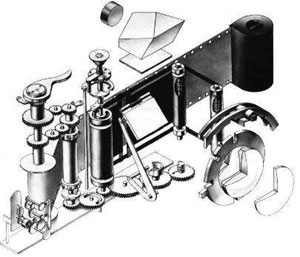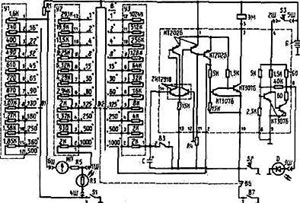
|
The ZENIT |

The most tested.
The most studied.
The most talked about.
The most perfected and updated.
The most complete and ever growing system.
The most reliable camera.
The Legacy for mankind.
The Mark that out sold all Japanese cameras together.
In a class by Itself.
Zenit is an SLR camera that has all the desirable characteristics of a
true photographic equipment.
Zenit sees no difficult or impossible tasks. Is the right companion of
the begining photographer, the true experienced amateur, the
serious professional and the high graded scientist.
Zenit sees the gratest permanence on the world photographic market. 50
years, and more! With the landmark of more than 58 million of
cameras produced, Zenit outsold SLR of all japanese makers
TOGETHER!
While some camera makers came and go, there is still Zenit
surviving them all.
Zenit is now considered the Legacy of photography and of mankind.
Practically using the same basis from the begining, it proved to be the
best formula to an usable reliable simple and versatile camera.
Seeing exactly the picturable object through the same optical
axis, it can be used from the common picture making to the microscope
up to the telescope. Can be fitted with a wide range of objectives, and
practically to any optical instrument.
Its pentaprismatic viewfinder, is built for a normal person eye, 0 to
1.5 diopters.
Its high precision elegant digital electronic through the lens
exposure meter give results with an accuracy of 1/3 of stop. Film
speeds from 25 to 640 ISO.
Well built controls, ergometrically designed, it is acomfort to use.
Quick and easy loading of film and interchangeable lenses gives the
best of its versatility.
Since its begining, in 1952, the Zenit camera is known by its
versatility, compactness, unlimited scope and completely failure proof.
As another pioneer first, Zenit was the first camera specially designed
to be coupled to the fabulous telescopics Maksutov catadiotric
lenses of 500 and 1000mm focal length lenses. The third integrated
pentaprism camera in the world, following the legendary Contax S
and the highly well built Italian Rectaflex, and antecipating by
several years japanese SLRs, The Zenit soon was accepted as a great
work horse due its easeness of using with regards to high quality
picture taking. The idea of a 35mm reflex camera has its roots in the
Russian Gelveta of 1932 and the Sport of 1935 antecipating the famous
German Exakta and Praktiflex of 1936 and 1938 respectively.
Zenit has the glory of being one of the very few cameras elected
to register the great conquests of our science history. Zenit was used
in the first view of the closed side of Moon, and in the first soft
Moon landing with Lunakhod robot.
The high demand of Zenit cameras world over, and impossible to suply
all requests, the original Krasnogorsk factory, delegated in 1971 the
Vileika Zenit factory also to produce Zenit cameras.
As a natural course of media, and conquering new markets, it was
evident that several other producing and commmercial enterprises all
over the world began to join efforts with the original Russian
factories in order to produce cameras meeting their specifications and
market requirements. By this reason we have now a series of models and
variants which were built in order to attain the most diverse
requirements, never going apart from the original Zenit project.
The Zenit 130, derived from 122 and 12XL models, was specifically built
in order to supply emerging countries, having the best of versatility
and factory accumulated experience in order to offer the maximum
quality and minimum selling price offering an unsurpassable
quality/price ratio,
and being the best companion to the beginer, the advanced amateur and
the best tool for scientific
researches.
See here the Zenit 130 and Zenit Historica.
CFC NOVACON DO BRASIL with his own several projects jointed Vileika
factory in order to together develop and put on production a new
generation of optical photographical equipment ahead of all
existing ones, while with contained prices. This formula has already
been successfully proved in our very first experiences.
Our main phylosophy is ruled by using highly proven principles, instead
of quick dieing novelties tested at buyer´s hands.
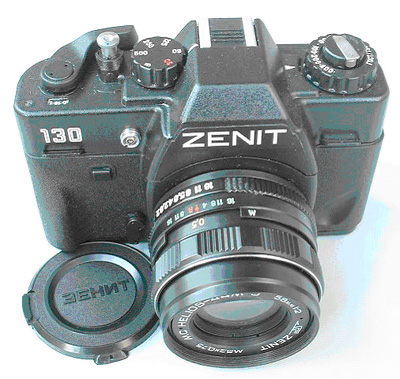
As previously said, the 130 range was developed in order to have the best Quality/Price ratio among Zenit cameras which by itself are too good winners.
This is obtained through meticulous reducing costs of raw material, reducing manipulation steps, simplifying the outside finishing, easying case construction in order to need less handcraft skills, and producing this new camera in a lower wages Country.
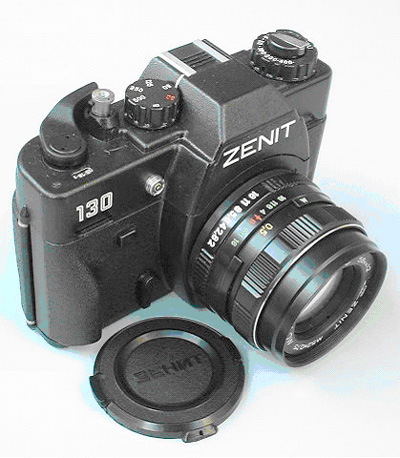
The overall quality is mantained, The commercial appealing features
such as auto ISO settings, are absent, but versatility is
extended always through manual settings, and being one of the only
cameras presently built to accept professonal electronic flash
sinchronizing. That is, built the necessary and get away from
superfluous.
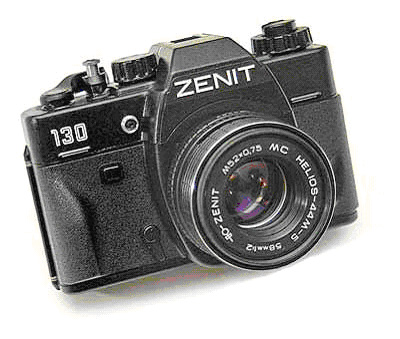
In a camera, the basic requisites are:
Strength, rigidness, precision, and light tight body
The Body:
Trully, the Zenit body is the strongest of all 35mm SLR cameras ever
built. This is due to the one piece injection moulding, with a high
tensile resistance alluminium alloy, which at once produce all critical
exact dimensions without needs of further machine precision
manufacturing. Other cameras are at least two piece moulded, and
this obliges further machining operations and higher skils to
bring them to exact standards when together. The Zenit method
diminishes precision fitting steps as well as diminishes rejected
parts, accelerates production and obviously drastically reduces
production cost without any quality expenses. The rendered precision
also contibutes in good fittings and light tight bodies So all
three requisites are fulfiled in one operation.
Very clever my Guy!
See here the body design.
Everything was done if we wanted pin-hole cameras, but we
aim a high precision low cost camera and of course, a
precision and reliable shutter is fundamental.
The Shutter:
The Zenit shutter is the best of all horizontal travelling
shutters ever made! It surpasses the quality of cameras
costing 20 times or more! And now we will show why.
At first, Zenit shutters are derived from Zorki Fed shutters which were
themselves derived from Leica Pre-war shutters. Modern Leicas too
derive from them.
Very slight differences, but intelligent ones, although improve an
extraordinary difference, not teoretical, but very practical
indeed.
*In all horizontal travelling shutters, of Leica or Leica origin
the cutain travels 39mm maximum from its close to open position. This
includes all Japanese cameras and several other cameras. Zenit shutter
travels 45mm! This radically changes the behaviour of the
shutter. The 6 first milimeters runs before the beginning
of film exposing.
*Now we will explain the exact events occuring in a shutter during its
exposing of film.
=In the commom Leica and Leica copies, the first curtain begins its
travel from zero speed very near the begining right side of the camera,
opening the light path, accelerates during its exposing of film and has
the maximum speed at the final course at the left of the frame.
=The second curtain begins closing the “travelling slit” and operates
similar to the first curtain. As the right side path is unquestionably
slower than the left, a compensation must be done. So the gap in the
right is slight smaller than the left. This is done by means of the
shutter order curtains placement and exact spring tension in each
curtain and the spring tension ratio between the two curtains. This
type of shutter, due the availability of materials and precision in
workmanship are limited in a maximum speed of 1/2000 which is the
Leicaflex maximum speed. At high grade quality costly precision
individual tunning.
As we said earlier, Zenit shutter has 45mm travelling space, or 6 extra
mm that does all difference.
This 6 extra milimetres run before film exposing and there acceleration
takes place before exposing the film giving unsurpassed
uniformity of exposing ,in shutters of this nature.
That is not all.
*Zenit is the only camera to have a roller bearing in the spindle of
the main curtain shaft. That means less friction, higher precision,
less variation around the main set value.
|
|
*All SLR cameras follows the same schematics.
You press the buttom, the first gear begins operation, lifts
the mirror and closes diaphragm. Ended this operation, is the
shutter fired opening the first and the second curtain for exposing.
This evolves the operation of some 40 precision parts.
*At Zenit cameras,
The shutter buttom operates diaphagm eliminating further
mechanics and offering a previous evaluation of the depth of
field.
Soon after, it immediatly fires the shutter, having no time lapse so
commom in all other reflex cameras. The 6 extra millimetres, operates
the mirror in time, which is part of the shutter mechanics.
Its initial weight and sudden inertia cutting, offers quicker
acceleration, greater moving uniformity higher repeatability of
results and quicker shutter firing, up to 1/30 before any of the other
cameras. With only 4 mobile parts instead of 40. You have again lower
cost, with higher quality. Greater allowances and tolerances in
manufacturing process, enables again lower costs and no quality losses.
You see here intelligence in place of complicated mechanics. The
Columbus egg in favour of the technology!
As final requisites for a high quality camera, we need a good exposure
meter and excellent optics.
Zenit exposure meters:
Are second to none, and follows the utmost minimalist phylisophy for
maximum precision. It is son of the last digital electronics
generation, and elegantly uses one or two photo elements, one
integrated “op-amp” (operational amplifier) with led indicators, and a
Weatstone bridge. More simple and lower cost impossible, at the present
state of the art. Its precision of up to 1/3 stop. Matches
cameras costing up o 20 times its cost. =Failure proof. In millions of
cameras produced, we cannot spot one hand of deffective components!
That means: Reliability above
all.
|
|
Zenit optics:
Although very low priced they are not cheap optics. And they favourably
competes with any series produced optics of any quality at any
price level. They are more transparent, give more resolution
gives better overall color tansfer than all the commom optics you know,
and incedibly they are less affected of fungus!
A super integrated vertical and horizontal factory
integration that produces all needed glasses, optics for
military and outer space purposes, and fine watch precision mechanics,
in a traditional country where the World´s first
Optical Institute was founded, could no less than produce the
World´s Best Lenses. Zenit is the only factory
with ISO 9002 . See here List of
Original Zenit lenses and important diagrams.
Russian Optics were World known before WWI but of low production. In
1928 It was founded the Progress Factory with Zeiss tecnnology to
perfect and develop mass production optics and microscopes. In 1938
Several Russian technology began to be used at Zeiss. The advent of
WWII and the later absorption of all Zeiss techniques turned on the
Russians as the most advanced in optics in the World. Their
technologies are sold to Japan, USA, Germany, Switzerland and other
extremely developed countries.
In Brazil, the ”Football Land” we say that “We do not modify
winner teams”.
So, why will we modify a so well done formula in a popular camera?
Can any one give us a so better proven technical concept like this?
A so ever living design?
A so versatile equipment?
What is really needed? -Expand its versatility and find new uses and
moods.
CFC NOVACON DO BRASIL the technology maker enterprise, jointed to
VILEIKA factory in order to develop a full family of “130”
series of cameras, conquering the World distribution rights of
this series of cameras and sell in Brazil the full line of Zenit
cameras.
The first True All Brazil Zenit camera is the “Zenit Mars” a macro
camera with unmatched capabilities. Conceived, born and built in Brazil
is unique in its concept!
That way, also, an unsurpassable post-sales services are available
because te same producer gives equipment maintenance.
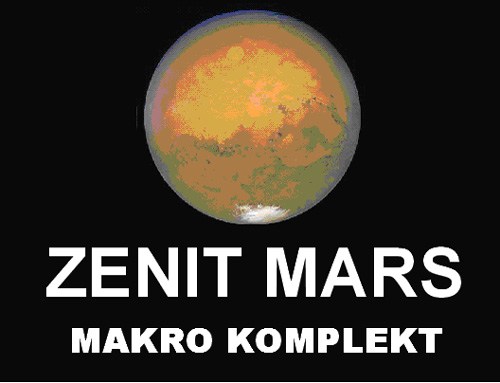
THE COMPLETE MACRO PHOTOGRAPHIC UNIT
Introduction:
In order to fulfill an important market gap we show here a well designed close-up macro device, with no similar concpt abroad.
This device, has some interesting particulars, and is extraordinary simple to use, yelding first class results.
It is nick-named the “Chornii-Glas” (Black-Eyes)
Description:
It is a self contained single piece camera /macro lens having a ring pulse flash and modeling lights built-in.
Its main quality is its constructional simplicity which favours long lasting and natural ruggedness.
Has a field operation from 1/1 to 1/17 reproduction sizes, being absolutely uniform the relationship Puse flash power/ lens factor according to all focusing points.
Uses:
Besides its enormous applications in Bothany, all medicine area, technology, etc it is also appliable as teaching, documentary, and pericial instrument.
The hobyist and colectionist of stamps, insects, flowers and small objects will find in the Mars the companion of their lives.
Construction:
We kept a simple but effective construction in order to keep the costs as lower as possible.
We mantained the essencial in order to avoid complication and aiming the best results.
Specifications:
Camera body: Zenit 130 series type body.
Micro raster focusing screen.
Preferencial speeed: 1/30.
Other speeds: B- 1/60 to 1/500.
Ocular with removable 2,5X critical focuser.
Objective: Special Industar 100U f4/110mm.
Diaphragm: Automatic positioning according to ISO and distances.
Reproduction ratio: from 1/17 to 1/1 in continous form.
Click-stops in: 1/1; 1/2; 1/2,5; 1/3; 1/5; 1/7; 1/10; 1/12; 1/15; 1/17.
Continous illumination of the photographing field. With LED indicator.
All manual integrated flash head with charged and discharged LED indicators.
Power source: 2 X 4 1,5 V cells.
Two 3/8” tripod bushes.
Everything needed for a good hand held macro photography is self contained in the unit.
Dimensions 320 X 160 X 120 mm.
Weight 980 g.
See Zenit Mars pictures here
